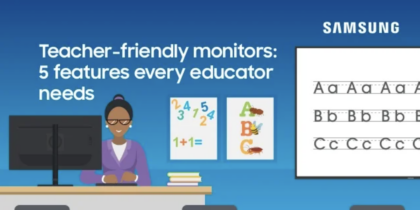When you’re trying to engage students and provide differentiated instruction that helps students of all levels succeed, you need the right tools. You want an interactive digital curriculum that includes a robust selection of text-based materials, videos and simulations that provide deeper insight into abstract concepts and interactive activities that further learning objectives. Without these key elements, students won’t receive the benefits of digital curriculum — they’ll just be stuck using a paper textbook that’s been ported to their tablet.
You also need a strong management system that lets teachers see how students are progressing through the interactive digital curriculum and enables control of devices when needed to either return students to task or ask them to pay attention to the teacher.
Interactivity Matters
Teachers have known for many years that students enjoy a discovery learning model where they can learn by doing. They also know that they must guide the discovery so that students, especially younger students, don’t get too focused on one element of the curriculum and that they don’t develop logical fallacies that will hinder further learning. Interactive activities within a solid digital curriculum provide guided hands-on experiences that offer discovery plus teacher guidance. They also play into students’ experience using interactive technologies outside of the classroom to keep them engaged in classroom subjects.
When looking at a digital curriculum, look for a blend of activity types to ensure that students of all learning styles have access to activities that resonate with them. Also look for a system that assesses student progress and provides additional activities to enhance learning of a challenging topic — and further work for students who need more of a challenge.
A Good Management System Is Easy to Use
Overall, you need the system to be easy for teachers to use. According to Karen Limbacher, editorial director at McGraw-Hill Education, teachers can be apprehensive about moving into a one-to-one computing environment because they’re worried the kids might know more about the technology than they do.
She also explained that these fears can be overcome in a few ways. The first is using a system that offers the control they need to manage their students, while they can also access feedback on how well each student is progressing and who might need extra help on each topic. This technology also should allow teachers to add in outside resources they enjoy using and are comfortable with.
When assessing a tool, make sure the dashboard is visually appealing and uses language and icons a teacher will easily recognize for the important functions.
The Thrive Interactive Digital Curriculum Works
When designing the Thrive™ digital curriculum for math, language arts and science, McGraw-Hill tapped into the Time to Know® platform and added their own research-based curriculum and activities to ensure that students and teachers had access to the best learning resources and the best delivery system for their one-to-one environments. Thrive allows teachers to take a set of classroom tablets or computers and feel comfortable using them with students right away. It also provides teachers with the support and tools they need to move from a stand and deliver model of teaching to being a guide for every student.
According to Limbacher, the strength of the tool for student learning is in the applets that lead students to the learning they need. The writing applet, for example, takes students step by step through the writing process. And math applets allows students to take abstract concepts and model them using graphs and virtual manipulatives. Additionally, there are frequent assessments that are completed within Thrive on the student’s tablet or Chromebook, which helps students feel comfortable using digital assessments that are required for many of the high-stakes tests they will need to take. “Together, the tools are more powerful than anyone could expect,” says Limbacher.
Looking for an integrated digital learning solution? Classroom in a Box combines digital curriculum including McGraw-Hill’s Thrive, together with Samsung Chromebooks or Galaxy tablets, and professional development, providing everything school districts need to jump start digital learning.







